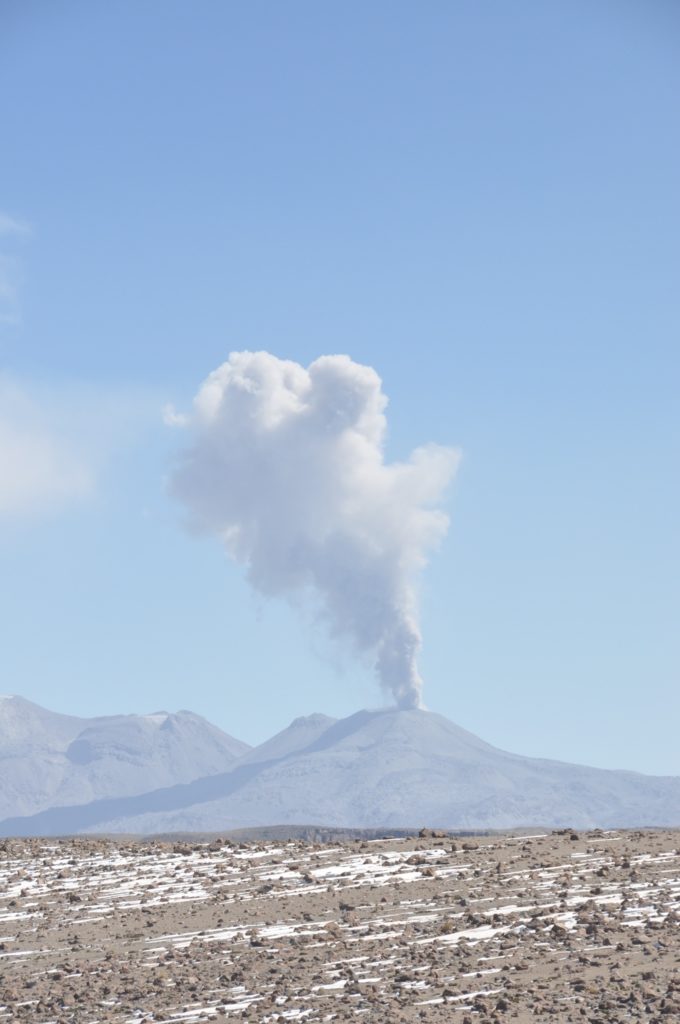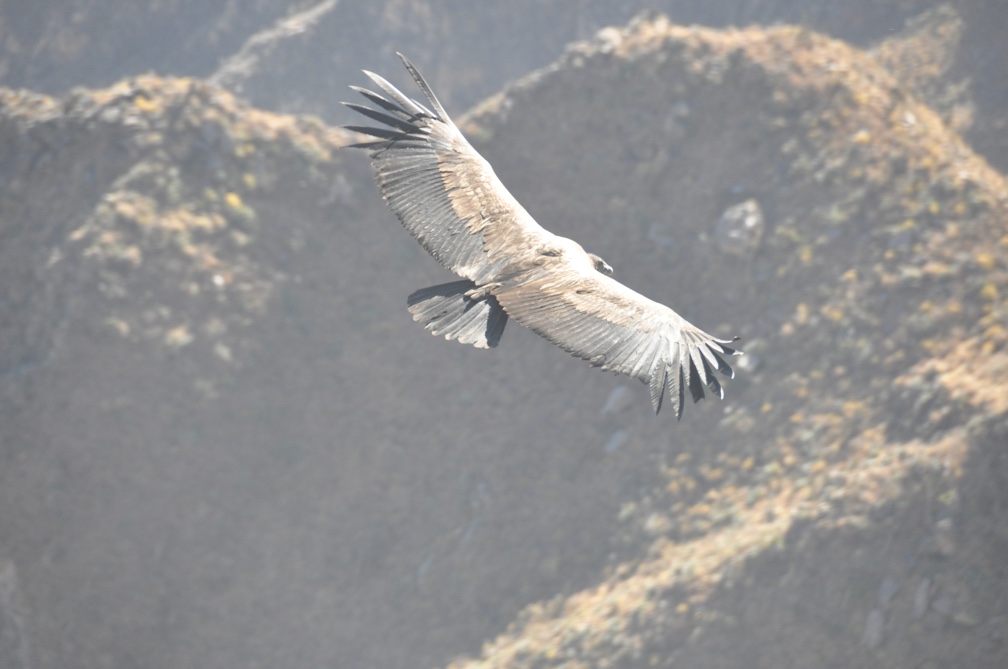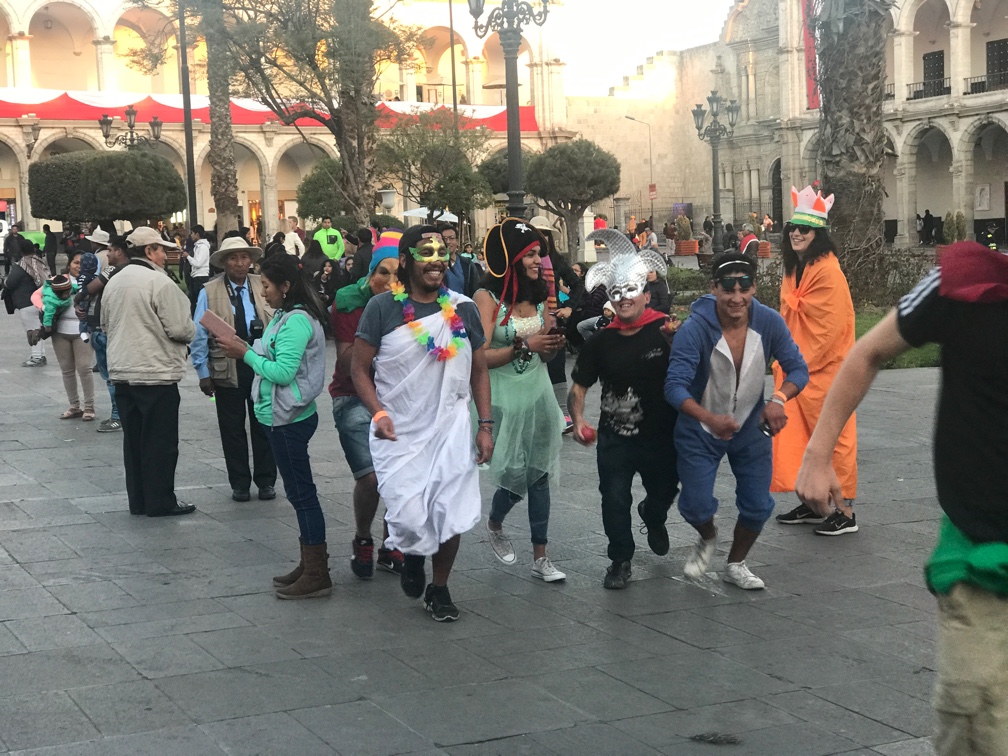Friday, July 26
The Peru Hop bus to Arequipa drove over a high pass. There was ice on the inside of the windows. We arrived around 3:30 am. The bus sat there with the engine (and air-conditioning) off for two hours. Ray wrote and complained. They wrote back and said that their contract with the people who actually drive the buses, is that the air conditioning is always supposed to be on. Finally they took us to our hotel around 6am, where we had a delightful breakfast on the third floor with a view of some rooftops. Hotel Los Tambos is modern on the inside, although being only a half a block off the square, they are constrained to keep the original façade.
At every major stop that Peru Hop makes, we scheduled a tour. This is how you’re supposed to use a hop-on hop-off bus. In Arequipa, that tour was to have a look at the Colca Canyon. We chose a short tour — you can spend an arbitrary amount of time. There are trails into the canyon. But juggling everything that I wanted to do, a long walk didn’t make the final cut.
We left the big pieces of luggage in storage, and took the small ones as we got picked up for the 9am Colca Canyon tour.

The first day of the tour took us up into the mountains, with many volcanoes visible all around. One of them, Sabancaya, actually spurts ash and gas pretty continuously. (Another smaller one, Ubinas, had had an eruption a few days earlier, but nobody was concerned that it would interfere with getting to Arequipa to Puno.) We ended up in the town of Chivay, where we had a dumb buffet lunch. We did little in the afternoon, going for a walk around sunset, wishing that we’d have done it earlier. We had a minimal dinner since we were still full from lunch.
The plaza at Chivay, and even the smaller towns around, is decorated with large statues, brightly colored. If the country weren’t Roman Catholic, you’d swear they were pagan deities.
I’ve been taking lots of pictures of people taking selfies on this trip. It’s the last moment to do that. No, selfie people aren’t disappearing from style. The absence of them is disappearing, and to be ubiquitous is equally the cloak of invisibility. We will soon not be able to see them.
Two decades ago, in Australia, I was impressed by the vast quantity of signs there were, everywhere, advising the public that they were being surveilled by video. I took pictures of those, too, because it was obvious that cameras would be everywhere in the world, soon, and there wouldn’t be signs, you would just assume, everywhere you were, that you were being photographed.
Does being watched increase the incidence of suicide attacks? It seems that criminals would be more discreet if they thought they might get away with it. But the GINI for crime is doing the same as the GINI for money: there are billionaires and paupers, and there are mad bombers and terrorized petty-criminals-manqué. Involuntarily Law Abiding. Should be an identity.
Saturday, July 27
In the morning, we drove along the rim of the canyon, stopping at a little town. More statues, more dancers. The dancers, who were children in large part, didn’t get it. They scowled and turned away when you got out your phone to take photos of them. Frowning at the camera fits into a narrative, if it’s a native woman in a market in La Paz who only wants to sell her 12 varieties of potato and go back to their barrios, but these dancers wouldn’t even be here, if tourists weren’t taking pictures of them. They’d be home on their Playstations. I guess they didn’t want to dance at all, and weren’t getting any money from it, and were sabotaging the whole scene.

Our guide told us that church ladies are divided by hat color. He says. Black and white. Different churches. I bet he was kidding.
Pretty soon we stopped at a place where about a dozen Andean Condors (Vultur gryphus) continuously flew around. At this point, the canyon started to get pretty deep. The stops continued at viewpoint after viewpoint, culminating at Mirador Cruz del Cóndor (there’s even a commemorating cross), where you may gaze 1200 meters down to the bottom of the gorge, or 15 or 20 meters in any direction, at the condors. If you look over the edge, you can watch them from above, as they soar against the backdrop of the black basaltic dropoff.

The condors have made their peace with the camera-intoxicated tourists. It is an exercise in co-evolution, or maybe just operant conditioning. The condors make dramatic approaches and swoops and aerobatics; the tourists follow them with their cameras over the cliffs, and the condors now have carrion to eat. The most photogenically performing condors therefore have the most food and reproductive success.

Colca Canyon is a pretty place but the only way it’s the biggest anything is by conflating the definition of watershed and canyon, pretending there’s a distinction. Except for a couple of gorges, it’s a broad agricultural valley. You might as well call the Amazon Basin a canyon. If you can’t afford to come to Peru, visit the Black Canyon of the Gunnison. Bring an Andean Condor feeding puppet.
After a few hours we returned to Chivay for another lunch. Most people seemed to bail on the lunch this time, as did we — we split an Arequipa sausage sandwich in a little shop instead. The tour returned to Arequipa the same way, and we actually checked into our charming hotel, Los Tambos.
We walked to the Plaza de las Armas and were immediately accosted by a crowd of Venezuelan exchange students or tourists, in costume, and shouting “Selfie! Selfie!” They must have been students. Tourists don’t pack masks and furry suits and togas. All the photos they take must be on Facebook or Instagram but you can’t find them, for privacy reasons. Make up your mind what you want, people.

We walked a little around the plaza at sunset, past the chain stores on the walking streets nearby, and to a restaurant I picked out, Picanteria Benita de los Claustros. They have menus of eight or four dishes, somewhat scaled down, but the menus of eight were said to be too big for two people, and those of four didn’t have the things we wanted. So we ordered three things a la carte, two of them involving the local crayfish (a “soup” and a “salad”). The other dish was the local stuffed hot pepper. It was all delicious, and the menu described it as typical of Arequipa food. I always suspect that genuine local people go home or eat at Five Guys. Their loss, if they do.
Sunday, July 28
We set the alarm and got up in time for the 5:15 pickup for the bus to Nazca. We found out that the arriving bus had been stopped at a blockade, and received an email as we sat there informing us that the bus had been rescheduled to 8pm. (They also called the hotel. Peru Hop is extremely communicative, often replying to emails within minutes.)
That gave us a day to walk around Arequipa. We were able to move into another room at the charming hotel for the day, and to get another hour of sleep. Unfortunately, it was a Sunday, and everything was closed (and it’s not a big museum town anyway). (It was also Independence Day, but we didn’t hear any anthems being sung or anything.)
We went to Yanahuara, a neighborhood said to have interesting architecture, and whiled away a bit of time. There was a glass platform up in the air with people wearing harnesses. We were hoping they’d jump or bungee down, but no, it was just an observation platform. A store nearby sold post cards of Old Peru that were too nice to send. A row of manikins representing historical figures was set up for people to take selfies with, together with QR codes to scan, for further information.
Back at Plaza de Armas, four more Venezuelan students wanted photos with us. They did not have costumes. The one who approached us was tall and extraordinarily handsome, and had two girls hanging off him while his mate had none and looked resentful in the photos.
Around 4 we started looking for dinner, and ended up at Victoria Panteria de Democratia, which is a sister restaurant of Benita. I was surprised it was open, since Google had said it would be closed, but the waiter said they changed that a month ago. I let Google know. So we had two more things a la carte from the menu of 8 things, a local salad, and “adobo”, pork in a nicely spicy sauce with an even spicier pepper.
The restaurant had a sign on the wall, among all the restaurant old stuff artifacts, slightly misquoting the French critic Eugène Viollet-le-Duc of the 19th century: “It is not to preserve it, to repair it, or rebuild it; it is to reinstate it in a condition of completeness which could never have existed at any given time.” The original quote was about buildings, but I suppose they were thinking of making traditional dishes. There was also a copy of Hal McGee’s book, “La Cocina y los Alimentos”.
We returned to the hotel, and got picked up and taken to the bus.